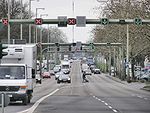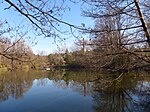Grunewald Tower
Berlin building and structure stubsBuildings and structures in BerlinMonuments and memorials to Emperor William ITowers in Germany

The Grunewald Tower or Grunewaldturm is a historical tower in the Grunewald forest of southwestern Berlin, Germany, built in 1897-99 according to plans designed by Franz Heinrich Schwechten. The viewing platform offers a view over the Havel at a height of 36 metres (118 ft).
Excerpt from the Wikipedia article Grunewald Tower (License: CC BY-SA 3.0, Authors, Images).Grunewald Tower
Havelchaussee, Berlin Grunewald
Geographical coordinates (GPS) Address External links Nearby Places Show on map
Geographical coordinates (GPS)
| Latitude | Longitude |
|---|---|
| N 52.478333333333 ° | E 13.196666666667 ° |
Address
Grunewaldturm
Havelchaussee
14193 Berlin, Grunewald
Germany
Open on Google Maps










